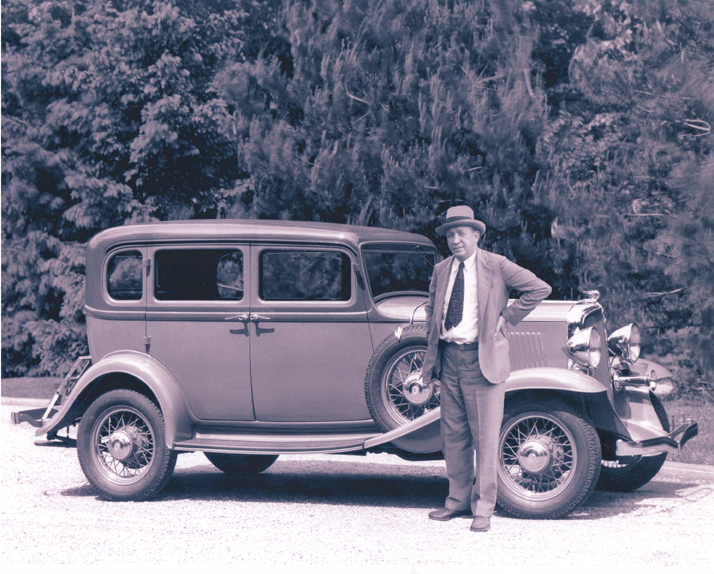Rockne “the pitchman”, representing Studebaker automobiles. Photo Courtesy of Augie’s Locker Room
Editor’s Note: March 31, 2023 marks the 92nd anniversary of the tragic death of Knute Rockne in a plane crash. Noted Rockne historian Jeffrey G. Harrell penned this piece on Rockne’s legacy, exclusively for Fighting Irish Preview.
Some who knew him swore he was shorter than the official five feet and eight inches claimed.
Could’ve been a pair of spindly legs that were bowed and crippled due to severe phlebitis. Then
there was a back-alley fighter nose that had been crushed when he was a teenage catcher by either a
foul-tip facial or a baseball bat in a brawl.
He was bald and could have passed for 51 when he entered Notre Dame at the age of 21.
“The first time I saw him, he looked like a man far too old for college” Notre Dame teammate
Gus Dorais once recalled. “He could have passed for a race track lout.”
Even the voice was a caricature, a staccato-pitched stammer excitedly heightened to a nasally
screech that could have called to arms a swarm of mosquitoes.
Knute Kenneth Rockne could have passed for just about anything other than the greatest
motivator in the history of persuasion.
But that common everyman exterior camouflaged a razor-sharp wit and keen intellect that
always ran three steps ahead of real-time life. Whether he was selling Studebaker automobiles, his own
line of Wilson sporting goods, or inducing his players to storm out of the locker room and destroy the
Notre Dame opponent of the day, Rockne possessed a masterful resourcefulness to come up with just
the right words to incite a rattlesnake and sell it its own skin.
“They were lies, blatant lies,” Four Horseman Jim Crowley once said of Rockne’s locker room speeches.
At the very Least, Rockne was the master at bending the truth into legendary proportions.
Little Billy Rockne had already seen a doctor to remove a peanut stuck in his nose by the time Notre Dame traveled to Georgia Tech in 1922, but Rockne needed a real tear-jerker to pump up the play to take on a powerhouse squad that was favored by 35 points.
He stood before his Fighting Irish holding several telegrams in his right hand. In his left was a lone wire.
“He said it was from his poor sick little boy, Billy, who was critically ill back in South Bend.” Crowley recounted to a sports publication years later. Added fellow Four Horseman Don Miller: “Rock told us, ‘Billy is ill and has been taken to the hospital.’ He then read the telegram, ‘please win this game for my daddy. Its very important to him.'”
By any truth necessary.
“We burst out after him onto the field, yelling and cursing our heads off,” Miller said, We tore that Georgia Tech team apart and beat’em 13-3. They never had a chance.”
When the train carrying the Fighting Irish pulled into Union Station in South Bend the following Monday, the first one to beat the crowd to his father was none other than Billy Rockne.
“You never saw a healthier kid in all your life. ” Crowley recollected.
Rockne’s truth lay in his relentless pursuit to keep his players laser-focused on their upcoming
rival. Don Hamilton, who served as a Notre Dame assistant coach in 1912 when Rockne was a player,
recalled Rockne putting “… a photograph of each man’s opponents in the sleeper so that that fellow
could look at him last thing before he went to sleep… and first thing when he woke up in the morning.”
But Rockne’s truth was never challenged more than the narrative that surrounded the fabled
dying words of George Gipp.
Who knows if Rockne kept, “… when the team is up against it, when things are wrong and the
breaks are beating the boys, tell them to go in there with all they’ve got and win just one for the Gipper”,
under wraps to himself for eight years until he needed it? Or whether he pulled a snake oil pitch in the
name of Gipp out of his trademark overcoat and hat on the spot at halftime when the team was
embroiled in a scoreless tie with Army at Yankee Stadium in 1928?
Rockne didn’t live long enough to defend his truth on the Gipp, or any of his legendary
speeches. Besides, it was Hollywood and actor Pat O’Brien as Rockne standing somberly at bedside
leaning his ear into actor Ronald Reagan as Gipp that immortalized “… win one for the Gipper” in the
1942 classic, “Knute Rockne: All-American,” released a decade after Rockne was killed in a plane crash
on March 31, 1931, at the age of 43.
A funeral broadcast on national radio for the first time in American history and a national
outpouring of grief normally reserved for a President grounded any and all superficial perceptions with
historical documented fact that Knute Rockne was a massive living force who died way before his time.
Unrecognizable physical remains vanished into a forgotten past now too long gone to credit
Knute Rockne his truth, as the original designer of the modern-day football. Lost in the wind is Rockne’s
cerebral fortitude that morphed a rounded semblance of a swollen watermelon made from a pig’s
bladder into a designed pigskin leather model with thick cross-stitched lacing complete with an air valve
to regulate pressure.
Rockne streamlined his truth into the original version of the modern-day football sold through
his brand of Wilson sporting goods. The first coach to implement a layered passing system in a football
offense recognized the need for a football to fit comfortably in the quarterback’s hand. Ask Tom Brady
about the importance of an inflated – or deflated – football in the hands of a quarterback.
Now, 92 years after his death, Rockne’s immortality lives on with the greatest of all-time
winning percentages dressed in a trademark overcoat, tie and hat shading a thick boxer’s mug that
forever smirks a quirky Mona Lisa smirk. It’s an exclusive image straight out of central casting that
remains the lasting image of the foundational face of not only college football, but football, period.
And, to this day, Rockne’s truth thrives in boardrooms across the country studied and mimicked
by coaches, managers, sales executives, teachers, military leaders and the like starting with, “… win one
for the Gipper.”
Does it matter that Rockne’s immortal truth has been filtered down through exaggeration and
exacerbated by Hollywood?
It matters about as much as that peanut they pulled out of little Billy Rockne’s nose.
Jeffrey G. Harrell is the author of “Rockne of Ages” and “As God’s Witness: The Death of Knute Rockne.” , and an occasional contributor to Fighting Irish Preview. For more on Rockne and Mr. Harrell see Spirit of Knute.

